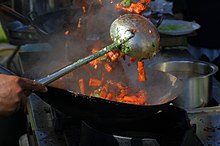Radical 193
| 鬲 | ||
|---|---|---|
| 192 ⾿ ◄ | 193 | ► ⿁ 194 |
| Pinyin : | lì (= boiler) | |
| Zhuyin : | ㄌ ㄧ ˋ | |
| Hiragana : | か く kaku (= boiler) | |
| Kanji : | 鬲 kaku | |
| Hangul : | 오지 병 | |
| Sinocorean : | 격 | |
| Codepoint : | U + 9B32 |
|
| Stroke sequence : |
|
|
Radical 193 , meaning " cauldron ", is one of eight of the 214 traditional radicals in Chinese writing that are written with ten strokes.
With four combinations of characters in Mathews' Chinese-English Dictionary , there are very few characters that can be found under this radical in the dictionary.
Radikal Dreifuss only occupies the 193rd position in the long - character list of traditional radicals , which consists of 214 radicals. In modern abbreviation dictionaries it can be found in a completely different place. In the New Chinese-German Dictionary from the People's Republic of China, for example, it is in 219th place.
This cult vessel made of bronze is still recognizable in the modern form of the sign. It comes from a chest-shaped clay pot that could be placed directly over the fire. The three legs are hollow to speed up heating. The sign shows the three legs, the container and the lid.
Character combinations ruled by radical 193
| Strokes | character |
|---|---|
| + 0 | 鬲
|
| + 6 | 鬳
|
| + 7 | 鬴
|
| + 8 | 鬵 鬶
|
| + 9 | 鬷
|
| +10 | 鬸
|
| +11 | 鬹 鬺
|
| +12 | 鬻 |
In the Unicode block Kangxi radicals the radical 193 is coded under the code point number 12.224 (U + 2FC0).
literature
- Edoardo Fazzioli : Painted Words. 214 Chinese characters - from picture to concept . Marixverlag, Wiesbaden 2004, ISBN 3-937715-34-7 , p. 127 .
- For detailed references, see List of Traditional Radicals: Literature
Web links
- Xiù cai.oai.de (PDF; 1.72 MB) Explanation of Radikal 193 on pages 43 and 117

